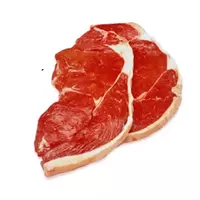Beef

Today, along with pork, beef belongs to one of the most popular varieties of meat. This meat, which is obtained from cattle, is characterized by excellent taste and nutritional qualities, and also has a pleasant aroma. Depending on the age and breed of the animal, beef can be tender, like veal, or tough enough due to the large number of coarse muscles. The nutritional value and calorie content of beef depends directly on the part of the carcass you choose.
Beef can be distinguished from pork by its appearance in a more saturated red color. But, unfortunately, recently unscrupulous manufacturers have very actively begun to use food dyes that mislead buyers who focus only on its color when choosing meat. But do not forget that not only the gastronomic, but also the beneficial properties of beef depend on the quality of meat.
It is known that the color of beef directly depends on the state of health of the animal (for example, a pale pink shade speaks of disease), on the method of slaughter (a saturated dark red color indicates that the cow was slaughtered without bleeding after that), as well as on compliance with storage standards (after several cycles of freezing-defrosting, meat is characterized by uneven staining).
Parts of beef
Different countries are characterized by their animal carcass cutting schemes, which depend on cultural and culinary characteristics. In our country, for example, parts of beef during cutting are referred to as follows:
beef brisket;
beef neck;
beef thin edge;
beef thick edge (ribeye);
beef pellets;
beef fringe;
beef tenderloin;
beef trouser;
flank beef;
beef oguz, thigh;
beef scapula;
poached beef;
shin beef;
beef costretz.
In cooking, beef is used to prepare a variety of meat dishes, the range of which is almost unlimited. So, for example, the meat of this animal is consumed in fried, stewed, boiled, smoked form, and also minced meat is made from it for cutlets, dumplings and burgers.
For most soups and clear broths, it is recommended to use a goblet, preferably with bone, which is called "sugar. " For these purposes, a pincer with a bone, the back of the costretz, the shoulder and scapula of the carcass are also perfect. But for borscht and cabbage soup you need more fatty meat - bangs (front of the brisket). When using such a part of beef as shin, it should be borne in mind that it is cooked for a long time, and the finished soup acquires a characteristic smell and stickiness. You can prepare the first dishes from pashina, as well as the costal part of the scapular part of the carcass.
For the preparation of fried meat dishes, a tenderloin (fillet) is considered an ideal option, in the absence of which the inner part of the bonfire and the upper part of the window are quite suitable. Stews, such as befstrogans, are made from the front of the brisket and the outside of the bonfire. For chopped products, such as cutlets, round rissoles, zrazes, meatballs, rolls, you can take a stub, a lower part of a pincer, arable land and a shoulder part. Everyone's favorite studs are prepared from the shin.
Beef benefits
The benefits of beef are not in doubt, as it is a source of full iron and protein that contribute to the saturation of the body's cells with vital oxygen. Especially valuable is meat for people who work physically or visit the gym.
Beef also has low-value proteins such as collagen and elastin. Collagen is known to be the main building material of the articular ligaments. Another benefit of beef lies in the presence of a wide range of nutrients, which include valuable minerals, including zinc, which our body needs to develop immunity.
Harm to beef
Despite all the beneficial properties of beef, there is an opinion that eating this meat in unlimited quantities can provoke colon cancer. Whether this is true or not is not scientifically confirmed, but in order to avoid possible harm to beef, it is worth refraining from abusing this food.
beef 198 kCal
Energy value of beef (Ratio of proteins, fats, carbohydrates - ju):
Proteins: 17 g (~ 68 kCal)
Fats: 14.4 g (~ 130 kCal)
Carbohydrates: 0 g (~ 0 kCal)
Energy ratio (bj | y): 34% | 65% | 0%
 Español
Español Français
Français Português
Português Русский
Русский 简体中文
简体中文 繁體中文
繁體中文 日本語
日本語 한국어
한국어 العربية
العربية Türkçe
Türkçe Қазақ
Қазақ Deutsch
Deutsch Italiano
Italiano Українська
Українська
